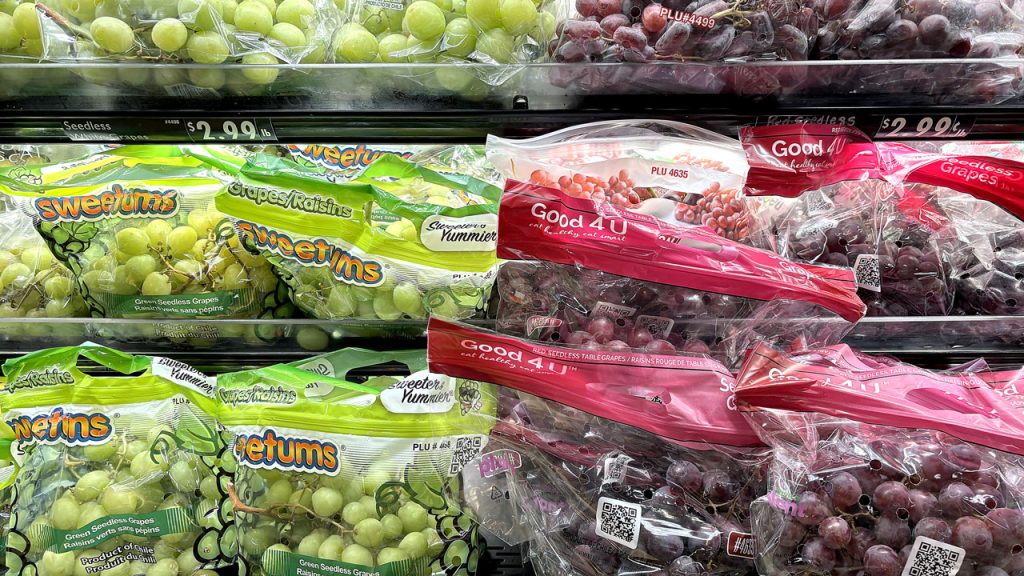Ride the Grape Wave
June 16, 2025 | 7 min to read

Shoppers love grapes: The bigger, the crunchier, the sweeter, the better.
Table grapes continue to thrive, despite ongoing inflationary pressures. U.S. per capita consumption reached 8.64 pounds in 2022/23, up from 8.49 pounds the previous 12 months, according to analyst Statista.
Furthermore, a 2024 survey of more than 1,000 consumers carried out by market researcher Forward Insight on behalf of fruit breeder Bloom Fresh found that 30% of surveyed shoppers were willing to pay more for premium grapes that promised better flavor and freshness.
That’s positive news for companies like TMK Produce, a wholesaler based in the Philadelphia Produce Market in Philadelphia, PA, which regularly stocks 75 different types of grapes, varying in size, color shades and flavor, even within the same variety.
“Grapes can be expensive and there can be quite a price difference between them,” says President Tom Kovacevich. “Knowing our customers, and our customers’ customers, enables us to properly place each lot into a store where it will sell best.”
Grapes are an item that gives retailers a chance to set themselves apart.
Tom Kovacevich, TMK Produce, Philadelphia, PA
“Grapes are an item that gives retailers a chance to set themselves apart,” he says. “Give your customers a quality experience in every way and they will come back and back. It’s fun to watch our customers so excited over how their customers are repeat buying.”
RETURN TO NORMAL
Although based in Delano, CA, Fruit Royale markets grapes, not just from the Sunshine State, but also from Peru, Chile, Mexico and Egypt. Managing Partner Louie Galvan describes the past 12 months as “interesting,” with demand outstripping availability from early Peru programs.
That was followed by an overlap with Chile, creating a backlog Galvan says has only recently cleared up. Next on the calendar — expected “fantastic quality” from Fruit Royale’s next producing region, Northern Sonora.
Closer to home, California’s table grape growers experienced a return to normal, according to the California Table Grape Commission. California table grape growers shipped 91.5 million 19-pound boxes of table grapes to 56 markets around the world, and conditions look promising in early-season Coachella Valley, says Nick Nakashian, the Fresno, CA-based commission’s director of content development.
Fresno, CA, grape shipper Bari Produce finished its 2024 season around Thanksgiving, and experienced what Justin Bedwell, president, calls a decent year in terms of yields and quality. “We had to work around some weather in the final third of our season, but nothing out of the ordinary, and nothing like the weather event of 2023.”
For Delano, CA, grower Pandol Bros. Inc., California grapes provoked a “stronger pull” in 2024, with central California volumes selling 15% above historical rates during late summer and early fall.
“It lasted too long and too strong to just be the absence of competing products,” says John Pandol. “Neither the retailers or the shipper have put our fingers on it.”
SPECIALTY APPEAL
For Alán Aguirre Camou, chief marketing officer for Nogales, AZ-based Divine Flavor, the past 12 months have been good in terms of volume, even if the weather doesn’t always cooperate.
The company, he says, benefits hugely from being able to source year-round from California, starting in August, followed by Peru, Chile, and Jalisco, Mexico, in March. Sourcing then moves to Sonora, Mexico, between May and July.
Divine Flavor’s varieties include Autumn Crisp — a “popular green grape with very good shelf life” — high-flavor Cotton Candy, red Gummy Berries (Candy Snap), and black Candy Dreams (sold as Jelly Berries).
Although red grapes have reigned supreme during recent years, Aguirre says green is gaining ground in North America. “Consumers want more crunch in their grapes,” he says, referring to the company’s success with Autumn Crisp.
Bedwell says Bari is best known for Autumn King green grapes, but has introduced more Great Greens and Sweet Globes to the market. The company has also seen an uptick in specialty varieties, especially Thomcords, Black Corinth, and natural Thompsons, which are available from late July.
But although newer varieties are on the rise, TMK’s Kovacevich says some traditional grapes, like Crimson and Autumn Royal, have not lost a step. At the same time, he emphasizes that regional and seasonal differences can play a major role.
“Every growing area has shown to produce the new varieties with somewhat different qualities,” he says. “We have learned we cannot expect Autumn Crisp from an early region, like Copiapo, Chile, to develop the same as one grown in a later growing region like Ica, Peru. These nuances make buying a bit tricky, as a Cadillac is not always a Cadillac.”
Pandol Bros. specializes in Sugar Crunch, Sweet Globe and Autumn Kings on the green side, and Flames, Sweet Celebration and Allisons on the red. At the same time, the company has between 10-20 varieties in evaluation, although John Pandol says the policy is “caution-first” after seeing several companies fail with new varieties.
One major trend has been the introduction of good green varieties to replace Perlett and Thompson Seedless after what Pandol calls “30 years of mostly red introductions.” Autumn King is the oldest and most produced of this group.
Galvan at Fruit Royale says Sweet Globe in green and Sweet Celebration in red are now front-runners in new varieties for spring supplies. But far from resting on its laurels, he says the company has other new varieties popping up at a rate that is “too fast to track.”
SHIFT AWAY FROM LEGACY
The past 12 months have also seen advances being made by varietal developers, among them Bakersfield, CA-headquartered Sun World International.

According to the company’s director of global marketing insights, Elena Hernandez, Sun World is expanding its licensed grower network, with increased acreage in key production regions, including Latin America, Australia and Europe.
Hernandez says Sun World is also seeing success for its newest release, the early-season seedless red Sugrafiftythree, marketed under the Ruby Rush brand.
“Specialty grapes — particularly those with standout traits like unique flavor or extra-large berries — continue to perform well when backed by brand recognition and merchandising support,” says Hernandez, citing the success of Autumn Crisp.
“Retailers and buyers are demanding distinctive, branded grapes that offer consistent quality, differentiated flavor, and extended availability windows,” she says. “There’s a shift away from legacy varieties toward premium, IP-protected varieties in consumer brands that support storytelling, shopper loyalty, and margin growth.”
Based in Pasadena, CA, Sun Pacific grows several grape varieties in the San Joaquin Valley, including Sun World’s Autumn Crisp and Ruby Rush, all of which it markets under its own Air Chief brand.
“We have seen really great results with Autumn Crisp and Ruby Rush,” says Sun Pacific’s director of marketing, Sarah Deaton. “Consumers are starting to understand there aren’t just green, red and black grapes. They are starting to recognize there are different varieties within the category because of their unique flavor and high-quality attributes.”
HANDLE WITH CARE
When storing grapes, Kovacevich says it is important to keep them cold, but when that is not possible, increasing the frequency of deliveries should be considered. “In our operation, being in Philadelphia and adjacent to the main ports, we are able to hand-select the lots on the piers. This way, we are never surprised, and we can be a reliable source for customers.”
Likewise, California Table Grape Commission’s Nakashian recommends immediately placing grape boxes in a refrigerated cooler, ideally at 30-32°F with 90-95% humidity.
“Grapes should be gently stacked in a produce cooler so air can circulate around them. However, they should not be stored in a direct air path to avoid accelerated dehydration,” Nakashian says. “Grapes tend to absorb odor, so it is best to avoid storing them next to green onions or leeks.”
Pandol agrees. “If you want it sold, keep it cold.” He also recommends never building a bigger display than a store can maintain, and making sure signs are in the right places.
When it comes to procurement and handling, Pandol recommends choosing the right type of supplier for your scale and capabilities. This, he says, might be a wholesaler that can offer a quick product turnaround, or it may be through cultivating relationships with suppliers. Pandol also suggests working with as many partners as possible to avoid being left with shortages if one goes out of business.
According to Hernandez from Sun World, temperature abuse and rough handling are the biggest threats to grape quality. “Carve out time to educate in-store staff on the value of premium branded grapes,” she adds. “The more they know about how branded grapes drive traffic, demand and increase cart sizes, the better they’ll merchandise and rotate product.”
Deaton from Sun Pacific says effective handling not only maximizes shelf life, but also helps grow a category that shows no signs of slowing down.
“According to Circana, the grape category added more dollars (+35%) than all other fruit types since 2020, and we’re proud to be a part of that growth,” she says. “We continue to bring proprietary grape varieties to market that are high quality and full flavored, which brings shoppers back for more.”
15 of 17 article in Produce Business June 2025

